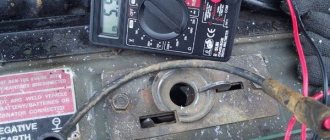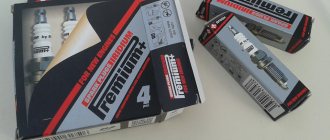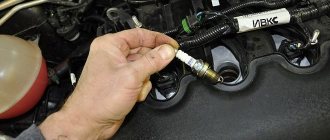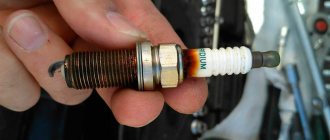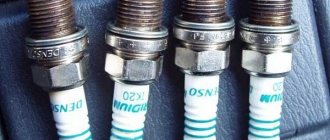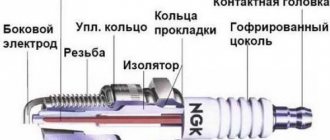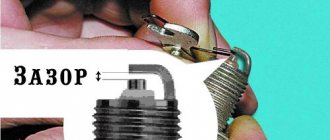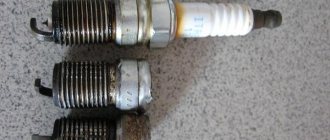What are the differences between spark plugs?
In addition to the obvious parameters, there are also those that are invisible at first glance. But they can cause difficult starting, interruptions, or even quickly lead to failure of the internal combustion engine. What differences should you pay attention to?
- Thread diameter and pitch - with inappropriate characteristics you will not be able to screw it into the cylinder head.
- The height of the threaded part - if a short 12 mm spark plug does not cause harm with a short mileage (until the free turns of the threads in the cylinder head become overgrown with soot), then a long one (19 mm) can “kill” the engine when it meets the piston.
- Heating number is one of the main parameters. Characterizes the thermal operating mode. Excessively “cold” spark plugs will not be cleaned and will become covered with soot, due to which the engine will become unstable. Hot ones will provoke detonation, up to glow ignition. Visually, you can distinguish by the thickness and length of the ceramic cone of the central electrode.
- The seal is a crushable ring or a conical fit (depending on the design of the internal combustion engine).
- Hexagon size - turnkey products are available from 13 to 25.4 mm. By installing larger ones, there is a chance that a “candlestick” with a larger diameter will not fit in the well.
- The connection of the high-voltage wire is a thread for a nut (obsolete type) or a tip of the SAE standard. If you have an old motorcycle, don't worry. For most products, the adapter is unscrewed.
- The number and material of electrodes - there are both classic ones with one side, and various modifications - with bifurcated, two, three, and even four dischargers.
“Multi-spark” candles received their popular name from the visual effect when, at a high frequency of sparking, we notice many flashes between all electrodes. In fact, there is only one discharge, and it occurs along the shortest path. But due to the fact that the distance is almost the same, it alternately jumps between different contacts, creating the appearance of simultaneous sparks in all directions.
Manufacturing methods
Several technologies have been developed for the production of magic candles, which involve mainly manual labor, but sometimes special machines are used, for example, pressing machines. The following methods are most widely used.
- Pouring. The prepared wick is held, evenly rotated around its axis, over a cauldron with molten wax, with which it is poured. The first portion of wax should be very hot so that the wick is well saturated. Next, the boiling composition is taken from the edges of the boiler, where the temperature will be lower. The process is repeated until the candle reaches the required diameter. After cooling, to give it a more “correct” cylindrical shape, it is rolled using a special device (magel) on a marble board.
- Notching. The wick is manually sealed with wax, previously liquefied in a water bath. At the end of the procedure, the finished product is also rolled with magel.
- To produce wax threads and very thin candles, the wick is pulled (passed) through a bath filled with melted wax.
- Dipping. The oldest method of making candles, in which the wick is simply dipped into the molten wax composition, first for a short time (about 3 minutes) so that it is well saturated. Next, the process involves executing a specific program for “dipping” the workpiece until it reaches the required size.
- Rolled. They are made from special wax sheets (foundation) of different colors and reliefs. In order for the foundation to roll up well before starting work, it is slightly heated, a wick is placed inside and “rolled” into cylinders. Before starting the magical ritual, it is recommended to keep them in the cold for a little while.
Candles made by hand are the most powerful because they have absorbed not only the energy of natural materials such as wax, plant elements, aromatic substances, but also the heat and energy of the master who created them.
“Hot” or “cold” candles - which are better?
The right choice is those that comply with the vehicle manufacturer's recommendations. Conscious deviation in one direction or another is acceptable when the user clearly knows for what purpose this is being done.
For example, the car idles mostly in traffic jams or does not have time to warm up during short trips - the standard version will quickly become covered with soot, because will not self-clean. Therefore, we need “hotter” ones.
If the engine is operated under maximum load (auto racing, drifting, towing a heavy trailer), then in order to avoid local overheating and detonation, it is permissible to install a “cooler” kit.
The optimal temperature in the arrester area is 400-850 degrees Celsius. The more heavily loaded the internal combustion engine, the colder the spark plugs are needed. Recommendations for the same power unit in different versions (industrial, marine, automotive, racing) may differ.
The meaning of a candle in magic
For a long time, candles have been used not only as lighting devices, but also in performing various magical rituals and in folk medicine. Magicians, shamans, adherents of various religious movements, regardless of the specifics of their beliefs, were united in their interpretation of the candle as the Universal Axis. Connecting the Heavenly Fire with the Earth's firmament, it serves as a symbol of unity and fills life with meaning. The Power of the Great Spirit flows through it, carrying positive energy, helping to free oneself from accumulated negativity, fatigue, and irritation.
Candles are still widely used today both as an independent ritual object and as an additional element that enhances the magical effect. Rituals with a burning candle will help in solving a variety of problems, from increasing sexuality and casting a love spell on a loved one, to increasing vitality, and eliminating injustice. The crackling of a candle while burning gives a positive mood, dispels sadness, dispels mental pain, and reduces physical suffering.
Candle magic is simple and accessible to use, because in this case no other additional elements are required, only candles and matches. It is possible (but not at all necessary) to have a special stand - a mini altar, the so-called “wish box”. This is a kind of box, on the top surface of which there is space for installing a candle. In addition, symbols can be depicted on it; if necessary, you can draw them yourself, which will enhance the effect of the ritual. It can be used repeatedly by setting and lighting new candles or incense.
During the action, you need to focus on the desire that you want to achieve. But, at the same time, you should carefully look at how the candle and its flame behave, through which energy flows flow.
- An even flame indicates that the procedure is proceeding correctly, the formulation of the desire is correct. You should expect your dream to come true as soon as possible.
- If the flame periodically trembles and fluctuates, then something is going wrong. Maybe you need to rephrase your wish. Or maybe the day or time was not chosen correctly for the ceremony. Or it is possible that it is the Universe itself, the Higher Mind, hinting that you do not need what you have planned at all.
- But the worst sign is when the candle wick does not light immediately. Perhaps you should not insist on fulfilling your desire, since it may harm someone else.
Candle magic involves using only candles when performing a magical action. However, there are a number of rituals in which the candle acts as an additional element. For example, very often a needle (pin) previously charmed and calcined in a candle flame is used as a protective amulet. This ritual does not apply to candle magic.
In general, a candle made of natural beeswax can be used not only for performing magical actions. It contains active substances produced by bees, such as propolis, natural resins, and essential oils. Thus, it is a natural flavoring agent that has an antimicrobial effect. At the same time, during combustion they release negatively charged ions into the surrounding atmosphere, provide bright, even light, help harmonize the room, and remove negativity from the human soul and body.
Spark plug markings
There is no single standard - the designation does not match between different manufacturers. In general, the number characterizes the time before glow (spontaneous) ignition occurs. The higher the value, the colder it is. The letter R (or Russian "Р") denotes built-in resistance to reduce radio interference.
The inscription on the insulator or housing encrypts the following data:
- thread diameter and length, key size and seal type;
- heat rating and heat cone protrusion;
- material of the central electrode and the presence of a resistor;
- dimensions, scope and design features;
- interelectrode gap, type and number of electrodes.
Within the framework of this article, it is not possible to give an exhaustive description of the labeling of various manufacturing companies; for this, an entire book would have to be written. But Topdetal consultants have the necessary information and will help you choose spark plugs for your car, offering several brands to choose from in different price categories.
Correct selection
Standard spark plug geometry: 14-19-16. 14 mm is the diameter of the threaded part, 19 mm is its length, and 16 is the size of the upper nut for which the spark plug wrench is selected. There are also less common versions of spark plugs with other geometric dimensions - it all depends on the seat in the engine head provided by the engineers. It is important that the spark plugs exactly match the calculated geometry. Installing the first spark plug you come across may result in damage to the engine piston and a major overhaul.
But it is impossible to select spark plugs only by thread size, because many more characteristics need to be taken into account: spark gap, heat rating, electrode material and their number... Therefore, spark plugs are selected according to special catalogs of manufacturers: Denso, NGK, Bosch. Or by the OEM number of the original spark plugs: to do this, you need to find the spark plug (spark plug) on the car component diagrams.
Whose recommendations should you follow: the car manufacturer or the spark plugs? Ideally, they should coincide, but sometimes there are discrepancies. Perhaps, priority should be given to candle brands - they know the features of their products better and regularly release new models that might not have yet existed when the production of your car began.
But the automaker's key requirements cannot be ignored. For example, if the instructions for the car indicate only iridium or platinum spark plugs, you cannot install ordinary nickel spark plugs, even if they are suitable in terms of geometric parameters. After all, the coils and the entire ignition system are not designed for the higher voltage required by spark plugs with a thick electrode, and such savings will sooner or later backfire. The same goes for the number of electrodes. If the engineers provided multi-electrode spark plugs, then there was a reason for this - these are the spark plugs that you need to buy. Choose your spark plugs wisely, and you won’t have to put a spark plug in for the health of your engine.
Which candle manufacturer should I choose?
Preferences depend on budget, knowledge and requirements.
- If you don’t want to delve into the intricacies of design and applicability, take the “original”. It was made by one of the “grandees” of the industry, and will definitely fit your car. This is the simplest, but most expensive option.
- You trust only “top” manufacturers - Bosch, NGK, Champion, Denso are at your service. These companies supply original spare parts to the assembly lines of car factories.
- Want to save money? A properly adjusted “civilian” engine will work no worse with Brisk, domestic ZAZS, inexpensive Finwhale or Lecar.
Is it worth overpaying for iridium and platinum?
If a specific core material (platinum, iridium, copper) is recommended for your car, you will have to accept it (or shorten the replacement period). Whether it is necessary to engage in tuning, changing ordinary ones to “fashionable ones” - everyone decides for himself. A serviceable engine works great even on stock ones.
Trying to revive a problematic engine that is “eating” oil and overflowing fuel is applicable as a temporary measure. It is possible that one of the several side electrodes will have less deposits, but the thin central one will still produce a flash. And the faulty internal combustion engine will start.
What is heat number
The heat number is a numerical value that expresses the period of time after which the spark plug is able to achieve glow ignition, which determines the level of compliance between the spark plug and the engine of a particular model. A large value of the heat number indicates the ability of the candle to heat up less, and a small value of the heat number indicates the opposite. Accordingly, the first type of heat rating designates a “cold” candle, the second - a “hot” one.
How to change spark plugs and what to do when a spark plug thread is torn off
Maintenance comes down to a visual inspection (checking with a spark probe and gap with a feeler gauge) or preventive replacement according to the instructions for the car (in Soviet times there were also collapsible spark plugs) with a mileage of 20-60 thousand km.
Leaded gasoline, malfunctions of the cylinder-piston group and difficult conditions (congestion, increased loads) can reduce the life of the kit. At the same time, there are known cases of operation for more than 100,000 kilometers.
Some practical recommendations.
- Replace only on a cold engine - tightened ones “from the heart” on a warm one will subsequently be difficult to unscrew.
- You should not exceed the recommended tightening force - the threads are thin, and the block head is usually aluminum. For precise dosing of torque, a torque wrench is useful.
- To make it easier to change next time, run a pencil along the threaded part - the graphite will not allow it to “stick” during operation.
If you overdo it and damage the thread, use a thread restoration kit with a “spring” or a screwdriver. If you have experience, you can do without removing the cylinder head - the repair will take less than an hour.
The meaning of candle color
Regular beeswax candles are yellow or tan in color, a natural hue found in beeswax. But today there are also bleached and colored products on sale. Magic in general attaches great importance to color, since it has a significant effect on the chakras - the psychoenergetic centers of the human biofield, through which energy is exchanged between the inner world of the individual and the surrounding world, the Universe. In addition, color affects the process of various events, human life, and various areas of his existence.
Therefore, when choosing candles for a specific ritual, you should take into account the combination, the ratio of the color of the magical attribute, the desire that the person seeks to fulfill.
- A universal color favored by both black and white magic is white. At the same time, it is considered the color of wisdom, purity, and innocence. People turn to him in those moments when they have doubts, want to improve their health, heal themselves, their soul and body from illness.
- The color black is already perceived on an intuitive level as evil and harm. Candles of this color are used to induce the evil eye and damage. But they can also be used to try to dispel the evil spell and remove the hex.
- The color of love and passion is red. Candle magic using red attributes will help you enter into new love relationships, strengthen established, habitual feelings, rekindle a “faded” fire, and bring back your former passion. A more delicate pink shade is suitable for romantic relationships that have just begun to develop.
- Orange is a cheerful, joyful, sunny color. A ritual with candles of this shade will help restore self-confidence, give strength to complete the most dizzying projects, replenish lost energy, and improve health.
- Yellow, like gold, is the color of courage and bravery. In addition, it helps strengthen and develop mental abilities and creative potential. Rituals with yellow candles are recommended for: students to successfully master complex educational material before exams; public people before important speeches, important, significant meetings; athletes before important competitions.
- The color green is responsible for attracting cash flow, success in business and career. In addition, magical actions with green candles help get rid of a painful illness, attract a bountiful harvest, and promote rejuvenation. And green with a yellowish tint helps to cope with anger, malice, envy, cowardice, and jealousy.
- Do you want to improve family relationships? Find peace and harmony? Use blue candles. This is the color of conviction, calmness, peace.
- A ritual using blue candles will help you stop and prevent the development of an undesirable event, cleanse yourself of bad, negative thoughts and emotions, intelligently assess the danger, and choose the right path.
- The most magical color is purple. With its help, you can develop your existing creative, extrasensory inclinations.
- The purple hue is considered no less significant in magic, as it can enhance existing magical abilities. Purple candles are used in spiritualistic seances, during rituals of clairvoyance, divination, to remove spells, and to treat serious illnesses.
- Silver is a “lunar” color, the strength of which it increases. It attracts stability into a person’s life and helps improve relationships with other people.
You should choose the color attributes for candle magic very carefully. The wax should be colored evenly throughout the entire volume. A candle painted only on the outside will not have a magical effect, and a ritual performed with its help will be absolutely useless.
Engine diagnostics based on spark plug condition
In addition to its direct function (sparking), it is an accurate diagnostic tool. By the nature of the deposit one can judge the quality of the air-fuel mixture and the state of the CPG:
- sandy shade, uniform - normal appearance;
- soot velvety - a rich mixture. Absent (white color) - depleted;
- tracks on the cone - “breakdown”, indication for replacement;
- black oily flakes - oil entering the combustion chamber;
- erosion, melting, chipped ceramic parts are signs of detonation.
Timely monitoring of spark plugs will ensure reliable engine starting, stable power characteristics and fuel economy. Spend a few minutes on the ignition during maintenance - and the engine will delight you with trouble-free operation.
Ilya Ilmarin
Number of side electrodes
The external special features of candles are electrodes; manufacturers constantly work magic on them. Both above the central one and above the side ones - there may be several of the latter.
Multi-electrode spark plugs were needed when motorists began to introduce the first ignition coils and the idle spark principle (for example, in the Toyota DIS-2 ignition system in the late 90s), where sparking occurs twice as often. This means that the wear of the electrodes is twice as high. To compensate for this, a second side electrode was added to the spark plugs: each time the spark jumps to the less worn one. Today there are candles with three or four electrodes.
Contrary to popular belief, several side electrodes do not improve sparking and combustion of the mixture, but they can increase the life of spark plugs on some engines. If a car manufacturer recommends multi-electrode spark plugs, it means that the ignition system used requires it, and they should be used.
This is interesting: What is better to fill the cooling system with antifreeze or antifreeze?
